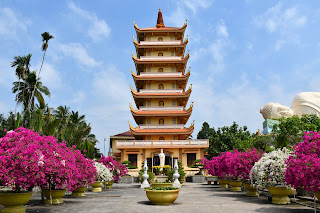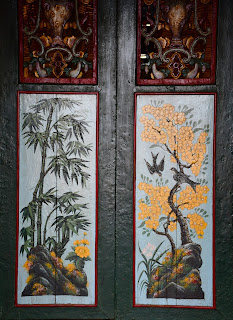Vietnam North to South – Day 16: On the Mekong
My dad and I woke up at half past six to eat a quick breakfast and check out of our hotel before embarking on our last adventure in Vietnam. Leaving our luggage at the reception, we walked over to the travel agency where we had previously workshopped our ideas for a trip to the Mekong Delta. Our driver and tour guide were already there.
It is a well-known
fact that tired people tend to find fault with many a thing they might otherwise
have overlooked. Throughout our trip, we have been sleeping progressively less,
getting more and more tired, and the above maxim fully describes our state of
mind. The car, we found, was full of mosquitoes, which kept emerging even late
in the afternoon. The tour guide, while perfectly amicable (one might almost
say chatty), was difficult to understand sometimes, and became almost
unintelligible when seated next to the engine of a cruise boat. What we did
understand were rather banal pieces of information: that a pagoda was nice and
old, that there were many coconuts on an island, and that the river is muddy. Perhaps
the guide was used to leading tours for the blind.
Our
destination was the city Mỹ Tho, which lies on Mỹ Tho River, a distributary of
the Mekong. Instead of making visits to various tourist traps like the coconut
candy factory and bee farm, we asked to see some local places of worship. Of
course, we unwittingly fell into many a tourist trap later on, gradually realising
that the main tourist destinations in the delta are essentially
government-sponsored theme parks.
We began at
the Vĩnh Tràng Temple, built (and rebuilt) in the nineteenth century. The main
things to see at this temple are its historic core, which contains many
beautifully carved wooden decorations, and its giant statues of Guanyin, Buddha
Maitreya, and the lying Buddha. The complex also features a tall pagoda, which
at the time of our visit was flanked by beautifully blooming bougainvilleas. My
dad and I also requested a short stop by the Cathedral of the Immaculate
Conception, which was closed but still worth a visit to see the pastel-coloured
exterior.
We soon
arrived at the harbour in Mỹ Tho, from which a flotilla of tourist boats
departs every day to visit nearby attractions. Joining the stream of visitors,
we rode the boat to Unicorn Island. There, we partook in most of the activities
prepared for us: we sat down to eat some fruit while listening to Vietnamese
folk music, took a stroll through an orchard, and had two ladies paddle us down
a canal shaded by nipa palm trees. This was my first exposure to what local
guides call the “water coconut” – the fruit of the nipa palm, which grows on
stalks in barnacle-like clusters. I tried juice made of this nipa palm fruit at
our next stop, which was a restaurant on Coconut Island. I can’t say the drink
was bad, but the fruit itself is not very flavourful.
Having
finished our itinerary for the islands quite early, our guide decided to dip
into our itinerary for the second day. Once we arrived in the city of Cần Thơ,
we visited the Munirensay Khmer Buddhist Temple. Completely unlike any temple
we have seen on this trip, this place of worship – with its golden ornaments
and dramatically rising roofs – is indeed very evocative of temples in
Cambodia, and it seems to be inhabited by Khmer monks. We also made a stop by
the Chinese Chùa Ông Temple, which did not strike us as unique but was
carefully decorated.
In the
evening, our guide and driver took us to a tourist restaurant, our travel
agency having decided that there were no good options within easy reach of our
hotel. As we walked along the pavement after our meal, we noticed many of the
bricks were heavily damaged. Our guide told us that this was due to flooding by
the Mekong River, whose violence the Vietnamese blame on dams built in Cambodia
and financed by China.







































Comments
Post a Comment